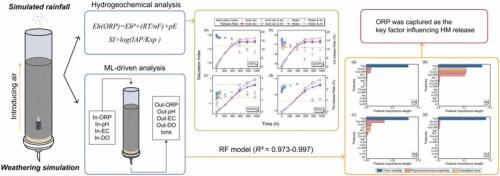Heavy metals release in lead-zinc tailings: Effects of weathering and acid rain
IF 12.2
1区 环境科学与生态学
Q1 ENGINEERING, ENVIRONMENTAL
引用次数: 0
Abstract
Heavy metals (HMs) release from lead (Pb)-zinc (Zn) tailings poses significant environmental risks to surrounding areas. Furthermore, with the natural weathering and frequently happened acid rain events, the release of HMs could be elevated. This study conducted a series of laboratory column experiments with thermodynamics and hydrogeochemical analysis to investigate the environmental behavior of HMs release in Pb-Zn tailings under natural weathering conditions and acid rain events. Results showed that the weathering of calcite facilitates the release of Pb (17.9 mg/kg) and cadmium (Cd) (0.15 mg/kg), while acid rain promotes Zn release (10.5 mg/kg) from the Fe-Mn oxides, with no significant change for arsenic (As). Among the influencing factors during the column experiments, the oxidation-reduction potential (ORP) was identified as the primary indicator for the predictions of the HMs release behavior based upon the Random Forest model (R2 = 0.973 - 0.997). Correlation analysis revealed a strong relationship between coexistent ions and HM release patterns. Therefore, saturation index (SI) could effectively identify the influence range of each mineral phase on HM release. This study provides scientific evidence for effective management in carbonate-type tailings ponds.

铅锌尾矿中的重金属释放:风化和酸雨的影响
铅(Pb)-锌(Zn)尾矿释放的重金属(HMs)对周边地区造成了严重的环境风险。此外,随着自然风化和酸雨事件的频繁发生,HMs 的释放量可能会升高。本研究利用热力学和水文地质化学分析进行了一系列实验室柱实验,以研究自然风化条件和酸雨事件下铅锌尾矿中 HMs 释放的环境行为。结果表明,方解石的风化促进了铅(17.9 毫克/千克)和镉(0.15 毫克/千克)的释放,而酸雨则促进了铁锰氧化物中锌的释放(10.5 毫克/千克),砷(As)的释放则无明显变化。在色谱柱实验的影响因素中,根据随机森林模型(R2 = 0.973 - 0.997),氧化还原电位 (ORP) 被确定为预测 HMs 释放行为的主要指标。相关分析表明,共存离子与 HM 释放模式之间存在密切关系。因此,饱和度指数(SI)可有效确定各矿物相对 HM 释放的影响范围。该研究为碳酸盐型尾矿库的有效管理提供了科学依据。
本文章由计算机程序翻译,如有差异,请以英文原文为准。
求助全文
约1分钟内获得全文
求助全文
来源期刊

Journal of Hazardous Materials
工程技术-工程:环境
CiteScore
25.40
自引率
5.90%
发文量
3059
审稿时长
58 days
期刊介绍:
The Journal of Hazardous Materials serves as a global platform for promoting cutting-edge research in the field of Environmental Science and Engineering. Our publication features a wide range of articles, including full-length research papers, review articles, and perspectives, with the aim of enhancing our understanding of the dangers and risks associated with various materials concerning public health and the environment. It is important to note that the term "environmental contaminants" refers specifically to substances that pose hazardous effects through contamination, while excluding those that do not have such impacts on the environment or human health. Moreover, we emphasize the distinction between wastes and hazardous materials in order to provide further clarity on the scope of the journal. We have a keen interest in exploring specific compounds and microbial agents that have adverse effects on the environment.
 求助内容:
求助内容: 应助结果提醒方式:
应助结果提醒方式:


